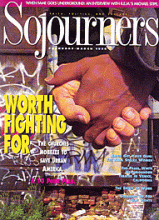Aprototypical white suburban mom walking toward her minivan in a dimly lit parking garage glances fearfully over her shoulder at some real or perceived threat lurking off camera. She is tightly clutching her young daughter's hand. Although it is a still photograph, one can almost hear the click of the woman's sensible pumps quickening with anxiety.
Turn the page. Susan Howard, an actress who appeared on the TV series Dallas, is photographed in a heroic pose: Arms crossed, shoulders back and square. Her hair seems to be blown back by the wind: Although she is wearing gold jewelry and a suit jacket in a studio, her stance is that of a climber who has conquered a mountain, a superhero perched on a skyscraper after a successful rescue. She gazes steadily at the reader: no-nonsense, confident, defiant, strong. "I refuse to be a victim," the headline declares. She is, as the caption notes, one of the "Women of the NRA."
Well goodness, who would you rather be - cowering potential victim or conqueror of fear?
These images are from a four-page ad running in women's magazines for the National Rifle Association's "Refuse to Be a Victim" program. It offers a free booklet of 42 ways to avoid and defend against criminal attack and promotes a three-hour course, for women only, on how to develop a "personal safety strategy." The $1 million dollar ad campaign was test-marketed in Washington, D.C., Miami, and Houston - cities with well-publicized crime problems.
The manipulation of fears, real and perceived, is much of what marketing is about, of course. And the use of threats, subtle and overt, to subjugate and use women is not new either. But the NRA's "Refuse to Be a Victim" campaign is an especially crass example of fear and threat cloaked as empowerment.
"You can regain the dignity of personal confidence every woman deserves," the text purrs on one page.
Read the Full Article
